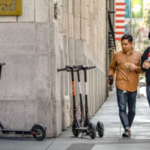Birds electric scooters are now in 100 cities and that number is growing. But some places, like New York, won’t see the scooters anytime soon.
Travis VanderZanden, Bird’s CEO, explained Tuesday how the company decides where to launch its dockless, rentable scooters:
It depends on the local laws. If there are already laws on the books banning the motorized vehicles, Bird doesn’t go there. But if the laws are vague, then it’s a go.
“We don’t go to New York because it’s technically illegal to use a scooter at the state level,” VanderZanden said Tuesday at the Vanity Fair New Establishment Summit in Los Angeles. “Where there’s no laws, that’s where we go in.”
Bird is the first company to launch rentable electric scooters in the US. It’s also the fastest growing Silicon Valley company in history. In about one year, it’s raised $415 million in venture capital funding, giving it a valuation of $2 billion. VanderZanden said 2.1 million people have tried out its scooters.
Santa Monica, California, was the first city in the US to get Bird’s scooters. The company first flooded the oceanside town with its vehicles in September 2017 — without warning to local officials or residents. Santa Monica didn’t have laws governing electric scooters at that time.
Within days of Bird’s launch, people were cruising down the beach boardwalk and in shopping zones. But at the same time, these new scooter riders were angering locals by cutting off pedestrians and parking the vehicles wherever they felt like it, blocking sidewalks, storefronts and wheelchair ramps.
The same scenario has now happened in cities across the country. Most of the time, Bird doesn’t forewarn officials that it’s about to drop hundreds of scooters onto streets. VanderZanden said that’s by design. The company’s MO is to reach out to city regulators at the same time it launches the scooters.
“Usually it happens at about the same time,” VanderZanden said. “If you wait to talk to the city, sometimes it can take too long.”







Comments are closed.